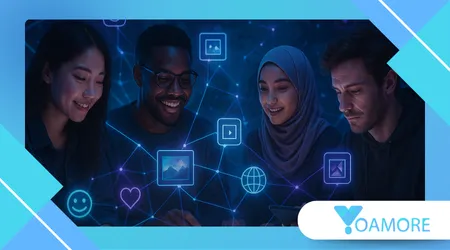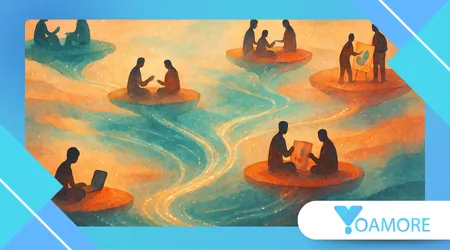Inside the World of Microcultures: How Small Communities Shape Global Trends

This article explores, in depth, the fascinating universe of digital microcultures, their origins, dynamics, and real impact on global consumer behavior and trend formation.
Anúncios
Below you’ll find a clear table of contents, followed by structured sections, authentic data, and an FAQ.
What Are Digital Microcultures?
Digital microcultures are relatively small online communities formed by individuals who share specific values, interests, or practices. Members interact frequently, build symbolic languages, and influence collective behavior through constant co-creation.
According to a 2025 study published in the International Journal of Finance and Management Research, these microcultures create “cultures within cultures,” where unique aesthetics, shared humor, and insider references shape identity and loyalty.
Rather than being defined by geography or demographics, they are united by common passion points. From niche gamer communities on Discord to minimalist-lifestyle groups on Reddit or TikTok, these networks cultivate distinct ways of speaking, consuming, and belonging — often influencing global trends far beyond their size.
Anúncios
Why Are These Communities Gaining Global Momentum?
The rise of digital microcultures is largely a by-product of audience fragmentation and algorithmic personalization. As mass media loses influence, people gather around hyper-specific interests.
Algorithms reinforce these bubbles by curating highly personalized feeds, encouraging stronger identity bonds.
A 2025 report titled The Rise of Micro-Cultures: Why Hyper-Niche Marketing Is the Future demonstrated that brands targeting such groups achieve engagement rates up to 60 percent higher than traditional campaigns.
Another 2024 study by IOSR Journals emphasized that members of microcultures are not passive consumers — they co-create meaning, influence peers, and act as cultural gatekeepers.
Global connectivity is another driver. A Brazilian fan of Japanese indie games can join a Tokyo-based Discord server instantly, creating a shared space for cross-cultural influence. In a networked age, local niches gain global voice almost overnight.
++The Invisible Power of Microcultures in the Digital Age
How Do Digital Microcultures Work?
Every digital microculture revolves around three pillars: belonging, symbolic language, and ritualized behavior.
Belonging and Recognition
Members seek acknowledgment and social capital inside the group. Engagement — commenting, creating memes, participating in live streams — becomes an act of identity reinforcement. Belonging is currency.
Symbolic Language and Aesthetic Codes
Each group develops its own aesthetic grammar: emojis, visual patterns, memes, slang, and in-jokes. Understanding and reproducing these symbols grants status. As IOSR researchers noted, “Dominance in a digital microculture depends on one’s fluency in its shared semiotics.”
Consumption and Action
Consumption inside these circles transcends mere purchasing — it signals belonging. Wearing specific brands, using certain apps, or joining events communicates in-group identity.
The ResearchGate paper “Identity Construction and Co-Creation in Digital Microcultures” highlighted that consumption acts as a form of symbolic communication rather than a transaction. (researchgate.net)
Table — Traditional vs. Digital Microcultures
| Characteristic | Traditional Microculture | Digital Microculture |
|---|---|---|
| Location | Geographically limited | Global, interest-driven |
| Interaction | Face-to-face, local events | Online (social media, chats, forums) |
| Symbolic Language | Local symbols, rituals | Memes, hashtags, digital visual identity |
| Consumption | Tangible goods and rituals | Symbolic actions, visibility, digital belonging |
| Scalability | Restricted to region | Potentially global through viral diffusion |
When and Where Do Digital Microcultures Emerge?
They typically arise when mainstream culture fails to meet people’s needs for connection, identity, or recognition. Whenever new digital platforms appear, fresh microcultures form around them.
The boom of Twitch and YouTube streaming spawned microcultures of gamers, ASMR creators, and music reaction communities. Discord’s architecture enabled “digital tribes” to flourish in real time, while Reddit facilitated collective intelligence through topic-specific subreddits.
Geographically, boundaries no longer matter. A microculture might originate in Berlin but expand to São Paulo and Seoul within weeks.
The pandemic years (2020 – 2022) accelerated this migration to digital spaces, forcing people to build their identities and social belonging online.
However, not all microcultures seek growth. Some prefer staying small, valuing authenticity over scale — their intimacy is precisely what attracts members.
++Village of the Twins: The Microculture of Igbo-Ora, Nigeria
How Do They Reshape Brands, Media, and Mass Behavior?

For Brands
Brands that understand and respect digital microcultures gain credibility, loyalty, and organic advocacy. However, these spaces demand authenticity — overt advertising often backfires.
According to the IOSR Journal study, “brand participation must mirror the community’s language and values to avoid cultural rejection.”
For Media and Platforms
Algorithms now act as cultural architects. They decide which content thrives inside microcultures. Traditional broadcast logic gives way to participatory dynamics, where authentic interaction outperforms paid promotion. Success means embedding the brand within the community’s creative ecosystem.
For Mass Behavior
Even though microcultures are small, their influence can be massive. Visual aesthetics, memes, and slang born in a single niche can spread worldwide within days. In this sense, today’s “mass culture” is a mosaic of micro realities.
A 2025 IJFMR paper reported that brands shifting from broad messaging to micro-focused strategies achieved sustained engagement growth of up to 38 percent.
++Meet the Reindeer Herders of Siberia’s Yamal Peninsula
How Can Professionals Leverage This Phenomenon?
1. Identify Relevant Microcultures
Start by mapping digital spaces where your audience gathers. Use social listening tools to spot emerging patterns on Reddit, Discord, TikTok, and niche forums.
2. Participate Authentically
Entering a microculture is about listening first. Respect its codes, tone, and aesthetics. Brands that imitate without understanding risk being dismissed as outsiders.
3. Co-Create Content
User-generated content (UGC) builds trust and symbolic value. Invite members to create with you — memes, videos, stories. Co-creation is not just participation; it’s collaboration that cements belonging.
4. Measure Beyond Visibility
Instead of tracking only clicks or impressions, analyze qualitative metrics such as community engagement, symbolic mentions, and organic growth. Microcultures reward long-term trust over short-term exposure.
5. Avoid Over-Segmentation
While targeting niches is powerful, excessive fragmentation can isolate brands. The IJFMR study warned against “hyper-segmentation that creates exclusive markets too small to scale.”
Conclusion
As the digital landscape fractures into smaller yet highly influential niches, understanding digital microcultures has become essential for anyone seeking to influence trends or connect genuinely with audiences.
These communities redefine consumption, belonging, and cultural creation. Traditional mass-market approaches are giving way to relational strategies built on co-creation and trust.
Success means listening, collaborating, and engaging with authenticity. Done well, these connections extend far beyond marketing — they reshape global culture itself.
For further reading on digital culture and consumer identity, see this authoritative article: Digital Consumer Culture and Digital Acculturation – ScienceDirect.
Frequently Asked Questions
1. What distinguishes a digital microculture from a regular online community?
A digital microculture is more than a group of people interacting online. It possesses shared values, symbolic language, and rituals that define identity and belonging.
Members create and sustain cultural meaning through ongoing collaboration.
2. How long does it take for a digital microculture to influence mainstream trends?
It varies widely. Some microcultures spark viral movements within days; others influence gradually over months or years. The speed depends on visibility, platform reach, and symbolic resonance.
3. Should brands engage with every microculture?
Not necessarily. Some microcultures value privacy or resist commercial involvement. The key is alignment — only join spaces where your values and intent genuinely fit. Forced marketing tends to backfire.
4. How can brands measure success inside digital microcultures?
Go beyond reach and impressions. Monitor organic mentions, UGC creation, comment depth, retention rate, and narrative integration. These reflect authentic connection more accurately than CTR alone.
5. Is there a risk in focusing too much on microcultures?
Yes. While niches offer loyalty and precision, over-targeting can limit growth and isolate a brand from broader audiences. Balance micro-level engagement with macro-level visibility for sustainable impact.
